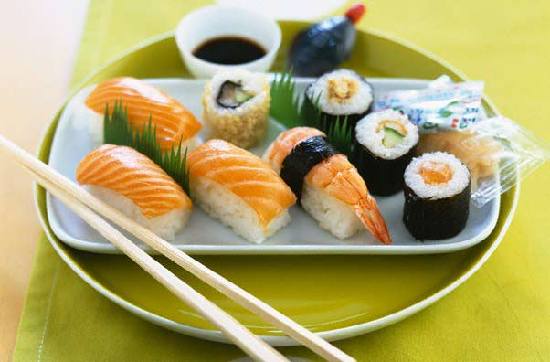|
 Not so healthy: A typical sushi roll contains 290 to 350 calories and has the carbohydrate equivalent of two-and-a-half to four slices of bread. |
|
Sushi is no longer the sole preserve of the adventurous diner. These days, grabbing a pack for lunch is almost as common as picking up a cheese and pickle sandwich. The Japanese dish can be bought from every major supermarket (where sales have risen a staggering 88 percent in the past two years). Indeed, the British sushi industry — of which Tesco has a 60 percent market share — is worth more than £56 million annually. The main reason for its surge in popularity is its reputation as a healthy meal. Japanese women are among the healthiest in the world, while slender celebrities such as Victoria Beckham, Cheryl Cole and Keira Knightley are all fans of the raw fish dish. But do sushi’s nutrition credentials — especially the Western version — stack up? Not always, according to dietitian Rachel Beller. In her book Eat To Lose, Eat To Win, she says a ‘light lunch’ of sushi may mean you overdose on calories and carbohydrates. ‘A typical sushi roll contains 290 to 350 calories and has the carbohydrate equivalent of two-and-a-half to four slices of bread,’ says Ms Beller. ‘So a California roll (round rolled sushi, containing a small piece of fish and avocado plus fatty mayonnaise) equals two sandwiches filled with crab sticks (processed fish that is flavoured and coloured to look and taste like crab), a sliver of avocado and a tiny bit of veg.’ Bear in mind a sushi lunch contains two or three of these rolls, a total of up to 1,050 calories, and it’s easy to see how we’re conning ourselves that we’re enjoying a low-calorie, healthy lunch. Many of us believe eating sushi is a good way to get the Government’s recommended two portions of fish each week, but here’s the problem: most sushi contains very little protein, despite its expense. Health experts say a portion of fish should weigh 140g, but on average, the fish in a California roll or piece of nigiri (rice with fish balanced on the top) weighs just 5g. You’d need to eat 28 pieces of sushi to reach your 140g portion — or more, if you choose a mixed sushi box containing vegetarian varieties. Even ‘fish’ sushi boxes don’t contain much. Marks & Spencer Fish Sushi Selection (191g, £4.68) has just 36g of fish, meaning you would have to eat four boxes and consume 1,184 calories to get one of your recommended fish portions. (Source: Dailymail) |
寿司不再是美食冒险家的专利了。如今,买一盒寿司作午餐几乎就像买奶酪泡菜三明治一样稀松平常。 在每个大型超市都可以买到这一日本料理(在过去两年内寿司销售量猛增了88%)。 事实上,英国的寿司产业(其中乐购公司占了60%的市场份额)每年收益超过了5600万英镑。 寿司变得如此受欢迎,主要原因是它被誉为健康食品。日本女性是全世界最健康的,而像维多利亚•贝克汉姆、谢丽尔•科尔和凯拉•奈特莉这些拥有苗条身材的名人都是这种生鱼料理的粉丝。 但是寿司(尤其是西方版寿司)确实有营养学证明吗?营养学家瑞秋•贝勒表示,并非总是如此。她在自己的书《瘦在饮食,赢在饮食》中说,一份“简单的”寿司午餐可能意味着你摄入了过量卡路里和碳水化合物。 贝勒女士说:“一个典型的寿司卷含有290至350卡路里,其碳水化合物含量相当于两片半到四片面包所含的碳水化合物。” “因此一个加州卷(圆形的卷状寿司,含有一小片鱼、鳄梨和含油脂的蛋黄酱)相当于两个夹有蟹肉棒的三明治(蟹肉棒是经过调味和上色、使其具有蟹肉的外观和口感的一种鱼类加工产品)、一片鳄梨和一点蔬菜。” 别忘了一顿寿司午餐包含两到三个这种寿司卷,总热量达到1050卡路里,这样很容易可以看出,我们以为吃寿司午餐是在享用低热量健康饮食,其实是在自欺欺人。 许多人认为吃寿司是达到政府建议的每周两份鱼的饮食标准的好方法,但是问题是:尽管寿司价格不菲,但大部分寿司所含的蛋白质很少。 健康专家称,一份鱼的重量应为140克,但是平均来看,一个加州卷或一个生鱼片寿司(把鱼片均匀地放在米饭上的料理)中的鱼肉重量只达到5克。 你将需要吃28个寿司才能达到140克的鱼肉摄入标准,或需要吃更多——如果你选择的是含有多种蔬菜的混搭寿司盒。 即使“全鱼”寿司盒所含的鱼肉也不多。玛莎百货的精选鱼片寿司(191克,4.68英镑)只含有36克鱼,这意味着你将必须吃掉四盒这样的寿司,摄入1184卡路里才能达到建议的鱼肉摄入量。 相关阅读 (中国日报网英语点津 陈丹妮 编辑:Julie) |
|
Vocabulary: avocado: 鳄梨 mayonnaise: 蛋黄酱 con: 哄骗 nigiri: 生鱼片寿司 |
